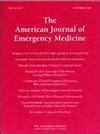外部验证广泛可用,局部败血症早期检测模型在急诊科设置
IF 2.2
3区 医学
Q1 EMERGENCY MEDICINE
引用次数: 0
摘要
研究目的已经开发了几种算法来帮助临床医生预测败血症的发生。其中最广泛使用的是Epic败血症模型。模型的第一个版本(V1)是一个逻辑回归,在外部验证中受到变量结果的影响。第二个版本(V2)利用了一个梯度增强树模型,该模型可以本地化到单个医院系统。虽然可以广泛使用,但V2还没有得到独立的外部验证。方法我们进行回顾性研究,比较两种模型在急诊科的表现。在满足脓毒症-3标准之前,在有临床识别脓毒症的证据之前(通过抗生素、培养或乳酸顺序识别),通过AUC-ROC对遇到水平的V1和V2进行模型判别。结果共纳入35076例病例。648例(1.8%)符合脓毒症-3标准。V1和V2的AUC-ROC评分分别为0.77和0.90。当仅考虑临床识别败血症证据之前的评分时,V1的AUC-ROC降至0.70,V2降至0.85。在针对60%敏感性的评分阈值下,V1和V2预测分别仅为33.0%和33.5%的病例早于败血症的首次临床识别。结论虽然V2模型在脓毒症临床识别前后的AUC-ROC均优于V1模型,但在有临床识别证据后,两种模型都倾向于对脓毒症进行预警。本文章由计算机程序翻译,如有差异,请以英文原文为准。
External validation of a widely available, localizable sepsis early detection model in the emergency department setting
Study objective
Several algorithms have been developed to assist clinicians in predicting the onset of sepsis. One of the most widely used is the Epic Sepsis Model. The first release of the model (V1) was a logistic regression that suffered from variable results in external validation. The second release (V2) leverages a gradient boosted tree model that can be localized to an individual hospital system. While widely available, V2 has yet to be independently externally validated.
Methods
We conducted a retrospective study comparing the performance of both models in the emergency department setting. Model discrimination was measured via AUC-ROC for both V1 and V2 at the encounter level, before sepsis-3 criteria were met and before there was evidence of clinical recognition of sepsis (identified by antibiotic, culture, or lactate orders).
Results
35,076 encounters were included. 648 (1.8 %) met sepsis-3 criteria. AUC-ROC scores were 0.77 for V1 and 0.90 for V2. When only considering scores before evidence of clinical recognition of sepsis, there is a drop in AUC-ROC to 0.70 for V1 and to 0.85 for V2. At a scoring threshold targeting a 60 % sensitivity, V1 and V2 predictions were earlier than the first clinical recognition of sepsis in only 33.0 and 33.5 % of cases respectively.
Conclusion
While V2 achieves superior AUC-ROC's to V1 both before and after clinical recognition of sepsis, both models tended to alert for sepsis after evidence of clinical recognition.
求助全文
通过发布文献求助,成功后即可免费获取论文全文。
去求助
来源期刊
CiteScore
6.00
自引率
5.60%
发文量
730
审稿时长
42 days
期刊介绍:
A distinctive blend of practicality and scholarliness makes the American Journal of Emergency Medicine a key source for information on emergency medical care. Covering all activities concerned with emergency medicine, it is the journal to turn to for information to help increase the ability to understand, recognize and treat emergency conditions. Issues contain clinical articles, case reports, review articles, editorials, international notes, book reviews and more.

 求助内容:
求助内容: 应助结果提醒方式:
应助结果提醒方式:


